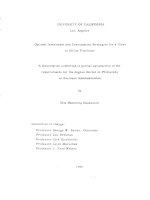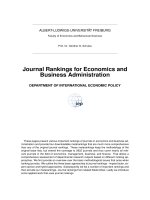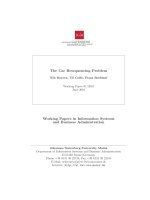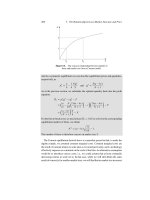Journal Rankings for Economics and Business Administration pot
Bạn đang xem bản rút gọn của tài liệu. Xem và tải ngay bản đầy đủ của tài liệu tại đây (152.23 KB, 11 trang )
ALBERT-LUDWIGS-UNIVERSITÄT FREIBURG
Faculty of Economics and Behavioral Sciences
Prof. Dr. Günther G. Schulze
Journal Rankings for Economics and
Business Administration
DEPARTMENT OF INTERNATIONAL ECONOMIC POLICY
These pages present various important rankings of journals in economics and business ad-
ministration and provide four downloadable metarankings that are much more comprehensive
than any of the original journal rankings. These metarankings keep the methodology of the
original base lists, but extend the coverage to 2822 journals and thus cover nearly all rele-
vant journals in the field of economics, management, business, and finance. That allows a
comprehensive assessment of departmental research outputs based on different ranking ap-
proaches. We first provide an overview over the basic methodological issues that arise when
ranking journals. We outline the three basic approaches to journal rankings - impact factor, ex-
pert opinion and hybrid approaches. Subsequently we list a number of important rankings and
then provide our metarankings. Journal rankings from related fields follow. Lastly we introduce
some applied work that uses journal rankings.
Contents
1 Methodological issues 3
2 Important Journal Rankings 3
2.1 Expert-Based Rankings . . . . . . . . . . . . . . . . . . . . . . . . . . . . . . . . . . . 3
2.1.1 VHB-List . . . . . . . . . . . . . . . . . . . . . . . . . . . . . . . . . . . . . . . 3
2.1.2 Vienna-List . . . . . . . . . . . . . . . . . . . . . . . . . . . . . . . . . . . . . . 3
2.1.3 Bräuninger and Haucap (2001) . . . . . . . . . . . . . . . . . . . . . . . . . . . 4
2.2 Impact-Based Rankings . . . . . . . . . . . . . . . . . . . . . . . . . . . . . . . . . . . 4
2.2.1 Kalaitzidakis et al. (2003) . . . . . . . . . . . . . . . . . . . . . . . . . . . . . . 4
2.2.2 Kodrzycki and Yu (2006) . . . . . . . . . . . . . . . . . . . . . . . . . . . . . . 4
2.2.3 Ritzberger (2008) . . . . . . . . . . . . . . . . . . . . . . . . . . . . . . . . . . . 5
2.2.4 RePEc-List . . . . . . . . . . . . . . . . . . . . . . . . . . . . . . . . . . . . . . 5
2.3 Hybrid Approaches . . . . . . . . . . . . . . . . . . . . . . . . . . . . . . . . . . . . . . 5
2.3.1 Tinbergen List . . . . . . . . . . . . . . . . . . . . . . . . . . . . . . . . . . . . 5
2.3.2 Combes and Linnemer (2003) . . . . . . . . . . . . . . . . . . . . . . . . . . . . 6
2.3.3 VfS Journal List . . . . . . . . . . . . . . . . . . . . . . . . . . . . . . . . . . . 6
2.3.4 Handelsblatt . . . . . . . . . . . . . . . . . . . . . . . . . . . . . . . . . . . . . 6
2.4 Aggregation . . . . . . . . . . . . . . . . . . . . . . . . . . . . . . . . . . . . . . . . . . 7
3 The Metaranking 7
4 Rankings for Related Fields 8
4.1 Political Science . . . . . . . . . . . . . . . . . . . . . . . . . . . . . . . . . . . . . . . . 8
4.2 Statistics and Econometrics . . . . . . . . . . . . . . . . . . . . . . . . . . . . . . . . . 8
5 Some Applied Work Using Journal Rankings 8
6 Appendix A: Different Methodologies, their Advantages and Drawbacks 9
7 Appendix B: Fur ther Important Rankings 11
7.1 Internal Kiel Institute Journal Ranking . . . . . . . . . . . . . . . . . . . . . . . . . . . 11
7.2 Liebowitz and Palmer (1984) . . . . . . . . . . . . . . . . . . . . . . . . . . . . . . . . 11
7.3 Laband and Piette (1994) . . . . . . . . . . . . . . . . . . . . . . . . . . . . . . . . . . 11
7.4 Theoharakis and Axarloglou (2003) . . . . . . . . . . . . . . . . . . . . . . . . . . . . . 11
7.5 Lubrano et al. (2003) . . . . . . . . . . . . . . . . . . . . . . . . . . . . . . . . . . . . . 11
7.6 The Keele List . . . . . . . . . . . . . . . . . . . . . . . . . . . . . . . . . . . . . . . . 11
2
1 Methodological issues
There are three basic approaches to journal rankings: rankings based on expert judgment, rankings
based on impact factors, and hybrid rankings. The different methodologies including their relative
advantages and drawbacks are explained in Appendix A or in Günther G. Schulze, Susanne Warning,
Christian Wiermann (2008): Zeitschriftenrankings für die Wirtschaftswissenschaften - Konstruktion
eines umfassenden Metaindexes [Journal Rankings for Economics and Business Administration - Con-
struction of a Comprehensive Meta-Index], Perspektiven der Wirtschaftspolitik, 9(3): 287-306.
2 Important Journal Rankings
Below we provide the most important journal rankings in the three categories.
2.1 Expert-Based Rankings
2.1.1 VHB-List
Compiled by the Verband der Hochschullehrer für Betriebswirtschaft e.V. (German Academic Asso-
ciation for Business Research) on the basis of the questionnaire among its members. The list has a
strong focus on business and management journals. There is a 2003 list containing 385 journals (if
only those journals at least 10 evaluations are considered) or a list of 681 journals (if journals with at
least 5 evaluations are considered), categorized into A+, A, B, C, D, E. The methodology is described
here.
The new 2008 list published contains 671 journals for which at least ten members offered a rating. 1555
members of the VHB were asked, 1010 responded. The journal value consists of the weighted sum of
an index of the referee process (if any) and an index on the quality of the articles as assessed by the
respondents. The respondents’ answers were weighted by a "competence factor" of the respondent.
The new methodology is presented here and published in Hennig-Thurau, Walsh, Schrader (2004):
VHB-JOURQUAL, in: Zeitschrift für betriebswirtschaftliche Forschung, 56(9): 520-545.
2.1.2 Vienna-List
The list of the Wirtschaftsuniversität Wien focuses on business administration journals. The list comes
in two forms: The "old ranking" covers 1,877 journals which are classified as A+, A, B, C, D, with the
classes containing in descending order 42 (class A+), 702, 734, 250 and 142 (D) journals. The "new
ranking" covers only 322 journals, which are rated A+ (32 journals) or A. The latter ranking is used
to reward publications in A journals with 1000 Euros and in A+ journals with 3000 Euros each.
3
2.1.3 Bräuninger and Haucap (2001)
Bräuninger, M., J. Haucap (2001): Was Ökonomen lesen und schätzen: Ergebnisse einer Umfrage,
Perspektiven der Wirtschaftspolitik, 2(2): 185-210.
Bräuninger, M., J. Haucap (2003): Reputation and Relevance of Economics Journals, Kyklos, 56(2):
175-198.
Email questionnaire among 2228 members of the Verein für Socialpolitik (the association of German-
speaking economists) with known email addresses, 430 responded and classified 149 journals according
to their reputation and the importance for their own work. Special focus on German, Swiss and
Austrian journals. Bräuninger and Haucap show that German economists value the journals published
in Germany, Austria and Switzerland more highly than international impact factor assessments would
suggest.
2.2 Impact-Based Rankings
2.2.1 Kalaitzidakis et al. (2003)
The List is published in Kalaitzidakis, P., T. Mamuneas and T. Stengos (2003): Ranking of Academic
Journals and Institutions in Economics, Journal of the European Economic Association, 1 (6): 1346-66.
The journal ranking compiles impact factors (adjusted for age, self citations and volume of journals)
for 159 journals with values from 100 to 0; comprises mainly economics journals.
2.2.2 Kodrzycki and Yu (2006)
The ranking was published in Kodrzycki, Y. K. and P. Yu (2006), New Approaches to Ranking Eco-
nomic Journals, Contributions to Economic Analysis and Policy, Vol. 5, Art. 24. Their ranking uses
the invariant method analyzed by Palacios-Huerta, Ignacio and Oscar Volij (2004): The Measurement
of Intellectual Influence, Econometrica, 72(3): 963-977. One of their main contributions is to show
how sensitive journal rankings are to the selection of the citing journals.
"The standard approach of restricting the list of citing journals to be the same as the list
of cited journals also results in inherent biases in creating rankings. Not surprisingly, it
raises the rankings for some economics journals that are likely to be read almost exclusively
by economists. It also misses the influence that economists might have on other fields of
scholarship."
Kodrzycki and Yu (2006, p.5)
Kodrzycki and Yu provide three lists of 181 journals from economics (including finance) each - the
lists take into account citations from (1) economics, (2) social sciences in general and (3) all policy
journals. The citations are impact weighted, control for size of the quoted journal by dividing by the
4
number of articles in that journal and take into account quoting habits of the citing journal by scaling
the citation counts by the citation intensity of the citing journal.
2.2.3 Ritzberger (2008)
Published in Klaus Ritzberger (2008): Eine invariante Bewertung wirtschaftswissenschaftlicher
Fachzeitschriften, Perspektiven der Wirtschaftspolitik, 9(3): 267-285 and in
Klaus Ritzberger (2008): A Ranking of Journals in Economics and Related Fields, German Economic
Review, 9(4): 402-430.
He compiles an impact based ranking following the invariant method (see methodology section) for 261
journals in economics and related fields with a clear focus on economics. In addition, he categorized
his list into an ordinal list by using his impact based ranking and that of Kalaitzidakis. His categorical
list contains 10 A+ Journals, 13 A journals, 15 B+ journals, 19 B journals and 30 journals for each of
the categories C+ and C. Schulze et al. classify a categorical list based on the impact based ranking
of Ritzberger (2008) only.
2.2.4 RePEc-List
"RePEc (Research Papers in Economics) is a collaborative effort of hundreds of volunteers in
63 countries to enhance the dissemination of research in economics. The heart of the project
is a decentralized database of working papers, journal articles and software components.
All RePEc material is freely available."
(www.repec.org, 18.11.2008)
The RePEc-List contains 596 journals from economics and calculates unweighted impact factors ("sim-
ple"), impact factors in which the citation is weighted by the impact factor of the citing journal ("re-
cursive") as well as "discounted" (recursive) impact factors for which the citations are divided by their
age in years. The list of recursive discounted impact factors are found here; links to lists based on
recursive and simple impact factors are on that page.
The REPEC list is based on the analysis by the CitEc project, which uses data from items listed in
RePEc. Citation counts exclude citations from the same series or journal. REPEC provides rankings
for journals and working papers (and combined rankings) and also for single papers and articles. Only
series or journals with 50 or more items are ranked.
2.3 Hybrid Approaches
2.3.1 Tinbergen List
List of the Tinbergen Institute (Netherlands) which classifies 132 journals into: 6 top journals (AA),
34 very good journals covering economics in general and the top journals in each field (A), and 92
5
good journals for all research fields within the Tinbergen Institute (B). Includes management and
business journals but focuses on economics. It is based on SSCI and SCI impact factors, the ranking
by Kalaitzidakis et al. (2003) and a more recent ’within economics’ ranking by Kodrzycki and Yu
(2006). For more details click here.
2.3.2 Combes and Linnemer (2003)
Published as Combes, P. und L. Linnemer (2003): Where are the economists who publish? Publication
concentration and rankings in Europe based on cumulative publications, Journal of the European
Economic Association, 1: 1250-1308. In their original ranking they ranked all journals contained in
EconLit, which were 680 current journals and 855 journals including those no longer referenced at that
time.
Combes and Linnemer assign the best five journals the weight 1, the next 16 the weight 8/12, the
following 39 the weight 6/12. Sixty-eight journals get 4/12 as their weight, 139 get 2/12 and the
remaining 1,030 journals covered receive the weight 1/12. The ranking of the journal thus depends on
the impact factor, but the relative weights are less skewed. Following this logic an updated journal
list would contain (at least) 1324 journals currently referenced (4.11.2008). The list of the currently
referenced EconLit Journals is here. The ranking is based on impact factors, but is much less skewed
than these. It assigns the leading field journal a weight of (at least) 1/2.
2.3.3 VfS Journal List
The list is compiled by the Committee for Research Monitoring of the Verein für Socialpolitik (the
German Economic Association). It contains all journals in EconLit and classifies them into 8 A+
Journals, 23 A Journals, 47 B+ Journals, 81 B Journals, and 122 C+ Journals with the remainder
being C Journals. The focus is on economics, but business journals are included as well. It contains
all EconLit journals and is based on the (1) Ritzberger list, (2) journal citation numbers compiled
by SCOPUS, a large abstract and citation database of research literature compiled by Elsevier, (3)
the original Combes - Linnemer list and (4) the judgment of members of the Committee for Research
Monitoring. It has been published (for journal classes A+ to C+, including methodological explana-
tions, in Friedrich Schneider and Heinrich W. Ursprung (2008): The 2008 GEA Journal-Ranking for
the Economics Profession, German Economic Review, 9(4): 532-538. All other EconLit journals are
ranked C.
2.3.4 Handelsblatt
One of the leading German business newspapers has put out its own ranking that is based on the
methodology of Combes and Linnemer (2003) and to a lesser extent on the Kiel Institute Journal
Ranking and the Tinbergen list. It has become quite influential for the German market as a ranking
6
of German economists is put out on the basis of this journal evaluation. Yet the values do not coincide
with the original Combes-Linnemer list. The Handelsblatt list contains 220 journals with a focus on
economics journals. Five journals are given the weight 1 (A+), 20 journals receive the 0.67, the next
20 journals have the weight 0.5, 33 jornals have the weight 0.4, 38 journals 0.3, 91 journals have the
weight 0.2 and 14 journals receive the weight 0.1.
The methodology can be found here. A critique on the ranking of economists which is based on this list
can be found in Hofmeister, Robert and Heinrich W. Ursprung (2008): Das Handelsblatt Ökonomen-
Ranking 2007: Eine kritische Beurteilung, Perspektiven der Wirtschaftspolitik, 9(3): 254-266.
This list is not exhaustive as there is a plethora of different journal rankings. Some further important
rankings can be found in Appendix B.
2.4 Aggregation
Note that ordinal lists, e.g. with classes A+, A, B, C, D, E need to be transformed in cardinal lists
if individual or department research output is to be aggregated. An obvious candidate would be a
scale 6, 5, 4, 3, 2, 1. Yet it is not clear that this would adequately reflect the difference in importance
for research. A scale like that in Combes and Linnemer (1, 2/3, 1/2, 1/3, 1/6, 1/12) may be more
appropriate, other scales may be sensible as well (which in part may depend on how large the different
categories are).
3 The Metaranking
The four metarankings contain 2822 journals each and thus are much more comprehensive than any
of the existing rankings. They extend a base list through a multistep imputation procedure but retain
the characteristics of the base list. We use as base lists the old VHB list, the Vienna list, the Combes-
Linnemer list, and our categorical version of the Ritzberger list.
The four Metarankings are here.
The methodology is explained in detail here. The published version is:
Günther G. Schulze, Susanne Warning, Christian Wiermann (2008): Zeitschriftenrankings
für die Wirtschaftswissenschaften - Konstruktion eines umfassenden Metaindexes [Journal
Rankings for Economics and Business Administration - Construction of a Comprehensive
Meta-Index], Perspektiven der Wirtschaftspolitik, 9(3): 287-306.
A brief description in English is found in
Günther G. Schulze, Susanne Warning and Christian Wiermann (2008): What and how
long does it take to get tenure? The Case of Economics and Business Administration in
Austria, Germany and Switzerland, German Economic Review, Vol. 9(4): 473-505, Section
3.3.
7
4 Rankings for Related Fields
4.1 Political Science
Hicks, Simon (2004): A Global Ranking of Political Science Departments, Political Studies Review, 2:
293-313
Giles, Michael and James C. Garand (2007): Ranking Political Science Journals: Reputational and
Citational Approaches, Political Science and Politics, 40: 741-751
4.2 Statistics and Econometrics
/> />5 Some Applied Work Using Journal Rankings
to be continued.
8
6 Appendix A: Different Methodologies, their Advantages and Drawbacks
In expert rankings journals are classified in categories, for example A+, A, B, C, D, according to some
aggregation of experts’ opinions. The simplest way is to conduct a survey, e.g. among the members
of a scientific association, and to calculate arithmetic means that classify the journals. The obvious
disadvantage is that such assessments are inherently subjective. Experts may not know all journals
equally well and they may be inclined to rank those journals better in which they have published or
hope to publish in the future. Such a bias could be unconscious; yet if the publication score is used
as performance indicator that influences resource allocation, an answering bias could be the result of
strategic behavior. Such a system is not incentive-compatible. Moreover the result depends crucially
on who is included in the survey (and who cares to answer).
Impact-based rankings calculate the rank of a journal by the number of citations that a journal com-
mands, where the citations are weighted by the impact factor of the citing journal and the number of
citations is standardized usually by the number of articles published in a journal (or alternatively by
the number of pages or characters of a volume). The invariant method additionally divides the number
of citations of a citing journal by the number of citations per article in that journal to account for
different citation intensities. The impact factor I of journal i after the t-th iteration is given by
I
i,t
=
n
j=1
C
ij
I
j,t−1
V
i
with I
i,0
=
n
j=1
C
ij
V
i
where C
ij
denotes the number of citations of articles in journal i by articles of journal j in a given
period (e.g. two years after publication). V
i
is the volume of journal i, measured by the number of
articles, the number of standard pages, or characters. Self citations are excluded. Palacios-Huerta
and Volij (2004) propose in an axiomatic approach to divide additionally by the citation intensity of
journal j; i.e. the number of citations per article in journal j. This ’invariant method’ accounts for
different citation behavior across journals or subfields. n is the number of journals, that are used to
count the number of citations that a journal commands. These journals are reported in the Journal
Citation Report (JCR) published by the Institute for Scientific Information. It contains about 1700
journals from social science; out of these were 160 in Economics in 2003.
Rankings by impact factors are more objective and less prone to strategic behavior, but they have
the severe drawback that they are extremely skewed. For instance, in the ranking by Kalaitzidakis et
al. (2003) a publication in the American Economic Review counts 1.7 times as much as a publication
in the Quarterly Journal of Economics (no. 5 in the ranking), five times as much as an article in
the Economic Journal (no. 18) and 25 times as much as an article in the respected Journal of Law,
Economics and Organization. A publication in Kyklos counts for less than 1%. It is debatable whether
these stark differences reflect the different values of the articles adequately. Another drawback of the
impact-based rankings is that the evaluation of journals is very sensitive to the selection of the journals
whose citations are counted. That has been shown by Kodrzycki and Yu (2006). For instance, if only
9
economics journals are used for the citation count, business journals will have a much lower rank
than if journals of the categories "business, finance, industrial relations and labor", and "business" are
included. The latter is what Ritzberger does in constructing his list. Also, publications in domestic
journals may have a larger importance for authors than that of a foreign journal with equal impact
factor. For a Scot the Scottish Journal of Political Economy might be more important than the
equally ranked German Economic Review as it reaches the targeted audience better. Bräuninger
and Haucap (2001) have shown with the help of an online questionnaire survey sent to the members
of the German Economic Association (Verein für Socialpolitik) that the respondents regard journals
published or edited in the German-speaking countries more highly than the impact factors suggest.
Lastly, citations are but a proxy for the scientific merit of a paper. Survey articles are by nature not
innovative, but are quoted very often. Thus the Journal of Economic Literature has such a high impact
factor.
The extremely skewed distribution of impact factors has led to hybrid approaches, notably that of
Combes and Linnemer (2003), which has been widely used. It is informed by impact-based rankings,
but then groups the journals into classes and assigns these classes increasingly lower values. Combes
and Linnemer assign the best five journals the weight 1, the next 16 the weight 8/12, the following
39 the weight 6/12. Sixty-eight journals get 4/12 as their weight, 139 get 2/12 and the remaining
1,030 journals covered receive the weight 1/12. The ranking of the journal thus depends on the impact
factor, but the relative weights are less skewed.
10
7 Appendix B: Further Important Rankings
7.1 Internal Kiel Institute Journal Ranking
The Internal Kiel Institute Journal Ranking is mainly based on: Yolanda K. Kodrzycki and Pingkang
Yu (2006): New Approaches to Ranking Economics Journals, Contributions to Economic Analysis &
Policy, 5(1). It is amended by journals deemed relevant but not contained in the above list. Those
journals are ranked mainly according to the publication record of the editor of the journal. (Hybrid)
7.2 Liebowitz and Palmer (1984)
Liebowitz, S.L. and J.P. Palmer (1984): Assessing the Relative Impacts of Economics Journals, Journal
of Economic Literature, 22(1): 77-88. (impact factors)
7.3 Laband and Piette (1994)
The classical article for ranking journals by weighted impact factors.
Laband, David N., and Michael J. Piette. (1994): The Relative Impacts of Economics Journals:
1970-1990, Journal of Economic Literature, 32(2): 640-666. (impact factors)
7.4 Theoharakis and Axarloglou (2003)
Also a classic, also dated.
Theoharakis, V. and K. Axarloglou (2003): Diversity in Economics: An Analysis of Journal Quality
Perceptions, Journal of the European Economic Association, 1: 1402 - 1423. (impact factors, 100
journals, focus on economics)
7.5 Lubrano et al. (2003)
Lubrano, M., Bauwens, L., Kirman, A. und C. Protopopescu (2003): Ranking Economics Departments
in Europe: A Statistical Approach, Journal of the European Economic Association, 1: 1367-1401
(hybrid). The working paper is available here.
7.6 The Keele List
List of the University of Keele; contains also information on the Blue Ribbon List and the Diamond
list.
11









